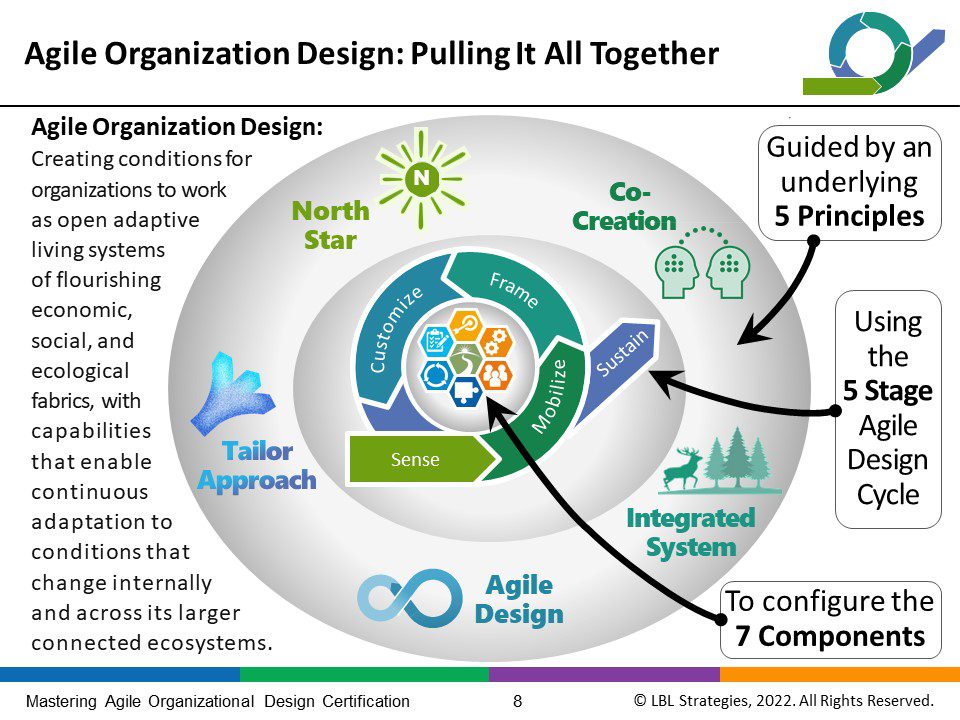In a world of buzzwords and trendy fads, creating plans for executing a strategic goal can seem overwhelming. Perhaps you’ve asked yourself these, or similar, questions when creating and putting in place your strategy:
“We have no down time to think about our strategy.”
“Everything is constantly in flux, so how can we possibly plan a strategy?”
“How do we put the strategy in place AND get our regular work done?”
Fortunately, Sarah Miller and Dr. Shelley Kirkpatrick’s new book, The Government Leader’s Field Guide to Organizational Agility, can help leaders in any organization—not only government leaders—address these challenges.
Throughout the early to late-20th century, work was typically carried out using tall, hierarchical structures and well-defined processes; this approach worked well when change was slow and predictable and the organization didn’t need to respond quickly. Nowadays, leaders face rapidly changing and complex environments, requiring quicker actions than are possible with centralized decision-making. Disruptions such as supply chain issues and employee attrition now affect almost every industry. One way to handle these and other disruptions is to enhance an organization’s ability to continually receive information and figure out how to rapidly respond—in other words, improve the organization’s agility. Fortunately, Miller and Kirkpatrick’s book provides practical advice and tools to help leaders enhance agility in their organizations.
CHARACTERISTICS OF AGILE ORGANIZATIONS
Agile organizations carry out work in a way that makes sense in a constantly-changing environment. They do this by getting everyone in the organization to sense and respond to that changing environment. Agile organizations make sensing and responding part of the way things are done with the following:
- Making decisions at the lowest level where expertise resides;
- Sharing information—including decisions that were made—as well as knowledge, and learning;
- Gaining speed and efficiency through well-defined processes in parts of the organization that are less affected by change;
- Increasing responsiveness by having more flexible processes in parts of the organization that are more affected by change;
- Investing in people by proactively building their skills;
- And, most importantly, creating sufficient psychological safety.
Without psychological safety, none of these things will happen.
Let’s explore why.
PSYCHOLOGICAL SAFETY IN THE WORKPLACE
When psychological safety is present, people – regardless of seniority or experience level – feel comfortable voicing their opinions, thoughts, and ideas. When psychological safety is high, people don’t worry that their ideas and opinions will be rejected or ridiculed. In fact, under these conditions, leaders find that people tend to:
- Ask for and provide help freely
- Share ideas and information
- Take calculated risks
- Are receptive to giving and receiving feedback.
On the flip side, workplaces with low psychological safety are often described as “cutthroat;” these offices contain employees who closely guard their work, don’t share ideas for improvement, and feel that they are in competition with their peers. Creating psychological safety requires time and investment from leaders.
Sarah Miller suggests thinking of psychological safety like a trampoline’s springy base. It can be difficult to climb on to, requires trust in yourself and your surroundings, and requires trust in others who are getting on the trampoline with you. This trust is essential before you can jump. Once your organization is on the trampoline, you can begin to use the kinetic energy you generate to increase the height of your jumps from agile element to agile element. The weight and vigor of the teamwork helps propel the change higher, and higher, and higher. However, without psychological safety, there is little energy or ability to create lasting change.
You can begin to build this foundation for your organization by:
- Sharing your own fallibility to model psychological safety
- Explicitly asking employees to share their experiences when things don’t go perfectly or as planned, then positively acknowledging them for their willingness to share those experiences
- Creating opportunities for employee ideas to be implemented by finding low-risk ways for employees to try and learn from their ideas; ask employees to report on their lessons learned and implement ideas that had positive results throughout the organization
Once you’ve established a solid base of psychological safety, you can continue to build momentum on the trampoline and facilitate lasting change.
You are probably asking, what happens after sufficient psychological safety exists? Look no further than Miller and Kirkpatrick’s guidebook, which contains 20 tools to help leaders develop behaviors that you can use when building your organization’s agility. Additionally, the tools are available on this accompanying website. The Government Leader’s Field Guide to Organizational Agility is available for purchase at Berrett-Koehler and other book sellers.
Shelley Kirkpatrick, PhD., is a Principal at The MITRE Corporation, a not-for-profit organization that operates research and development centers for the federal government. Her work focuses on organizational agility and assessment.
Cait Smith is an Army Fellow at The MITRE Corporation. Her work focuses on organizational change and organizational design.
Ellen Carpenter is a Lead at The MITRE Corporation. Her experience in organizational change spans both public and private sectors.
Mastering Adaptive Organizational Design Certification
Hone your skills and expertise in organizational design with LBL’s Mastering Adaptive Organizational Design Certification program.

This certification program trains professionals from all sectors to construct high-performing, agile and responsive organizations. Program participants will learn how to anticipate and overcome shifting priorities and unforeseeable obstacles through the practical application of organizational design principles, by strengthening team collaboration and by placing more emphasis on systems thinking, planning and action.
2022 Program Dates:
- June 7-9, 14-6 & 21-23
- October 11-13, 18-20 & 25-27
Classes are held via Zoom from 1:00-4:30 p.m EST
Cost: $2,975
Group discounts available. Email contact@lblstrategies.com for details or to reserve a seat.
